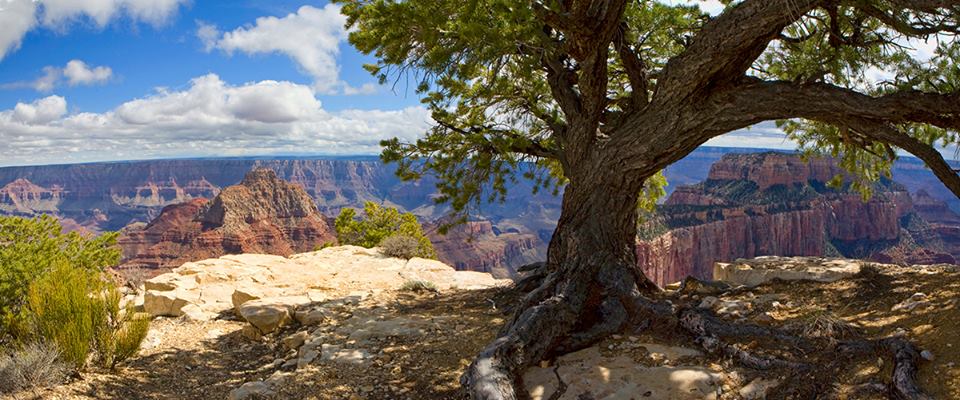News Release

NPS Photo
News Release Date: July 25, 2019
Contact: Marco De Leon, (303) 969-2321
WASHINGTON - The National Park Service (NPS) and the Department of the Interior (DOI) completed an interagency safety review finding no radiation exposure health risk to employees or visitors from uranium ore samples at Grand Canyon National Park.
The NPS and DOI initiated the review following an environmental audit flagging uranium rock samples in the Museum Collection building at the park’s South Rim. An investigative team of radiation, industrial hygiene, and safety and occupational health experts were sent to the park in February to identify the potential level of exposure and risk to visitors and employees. In March, the team announced its preliminary findings, which are confirmed in this final report.
The team contracted with a technical firm to conduct a radiation dose reconstruction to determine the level of exposure when rock samples were stored in the facility; interviewed employees to document the manner in which the materials were stored, employee work practices and likely exposure pathways; analyzed past assessment reports and available radiation safety practices; and developed recommendations for managing collection samples in the future. Additionally, the National Institute of Occupational Safety and Health of the U.S. Centers for Disease Control and Prevention reviewed the report for accuracy.
"When we started this investigation, we wanted to be absolutely sure we had all of the necessary experts at the table. After assembling the team and collecting our data, I am relieved to announce that our comprehensive review identified no health concerns with radiation exposure from the park’s uranium ore samples," Chief of the NPS Office of Risk Management and safety review team lead Michael May said. "I want to thank the safety team for their dedicated work, our colleagues from the National Institute for Occupational Safety and Health for their careful review of our report’s methodology and findings, and the park staff and public for their patience and concern."
The team surveyed the locations within the Museum Collection building where the buckets containing uranium ore were stored and determined the areas to be free of residual contamination. Taxidermy specimens from the natural history collection that were stored in close proximity to the buckets containing uranium ore were surveyed and determined to be free of residual contamination as well. The team provided recommendations regarding the handling of museum mineral specimens, including uranium ore and other specimens that contain naturally occurring radioactive elements.
The Museum Collection building is a storage and research facility dedicated to preserving the physical artifacts that tell the Grand Canyon story. The building is located in an administrative area that is separate from visitor use areas. Tours are by appointment only and visitation averages up to 1,000 visitors and researchers annually. The NPS stores objects and documents as part of research collections and to have representative samples of park resources.
Please visit the National Park Service website https://www.nps.gov/grca/learn/historyculture/muscol.htm for additional information.
View the final report
Final Report - Grand Canyon National Park 2019 Safety and Health Review Report
Frequently Asked Questions
The safety team was an interagency team of experts from—
-
Department of the Interior (DOI) Office of Occupational Safety and Health
-
National Park Service (NPS) Office of Risk Management
-
DOI Chief Medical Officer
-
NPS Office of Safety, Health and Wellness (Pacific West Region)
-
DOI Chief Industrial Hygienist
-
NPS Mining and Abandoned Mineral Lands Program
-
NPS Epidemiology Branch
-
NPS Office of Public Health
-
NPS Contaminants Cleanup Branch
-
AECOM Technical Services, Inc., Certified Health Physicist
The review team was tasked with investigating the exposure of park employees or visitors to radioactivity from uranium ore stored in the park’s collection, determining whether the health and safety of any park staff or visitors may have been materially impacted, and recommending next steps to strengthen park safety. The investigative team:
-
Conducted a facility assessment including a radiation dose reconstruction to determine the level of exposure when rock samples were stored in the facility.
-
Interviewed employees to document the manner in which the materials are/were stored, employee work practices and likely exposure pathways.
-
Analyzed past assessment reports and available radiation safety practices.
-
Developed recommendations for managing collection samples in the future.
The safety team recommended that the National Park Service 1) develop written policies and procedures to ensure that employees and managers are aware of potential hazards within their workplace and take appropriate actions to mitigate risk; 2) provide appropriate safety and health training for employees based on their workplace exposures and potential exposures—including training for chemical, physical, and biological hazards arising from museum objects; 3) implement an ongoing facility inspection program to identify, document, and correct hazards in the workplace; and 4) while there is no immediate health concern, wipe down cabinets were park employees stored the uranium ore with lint-free cloths and mild non-hazardous cleaning solution to remove the low-level residual contamination.
Last updated: August 7, 2019
